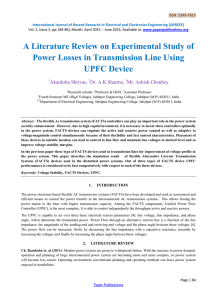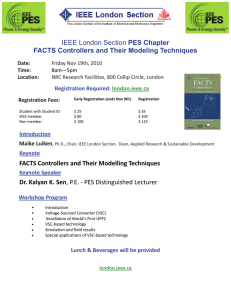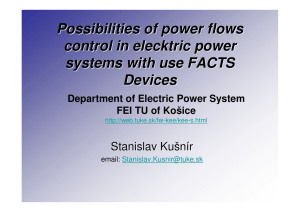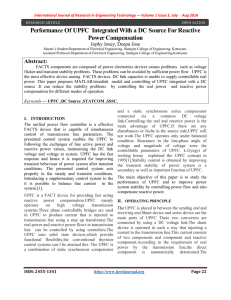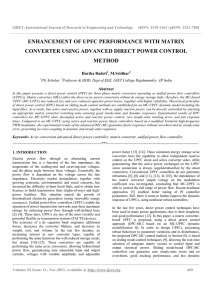Multimode Power Controllers For Three
advertisement
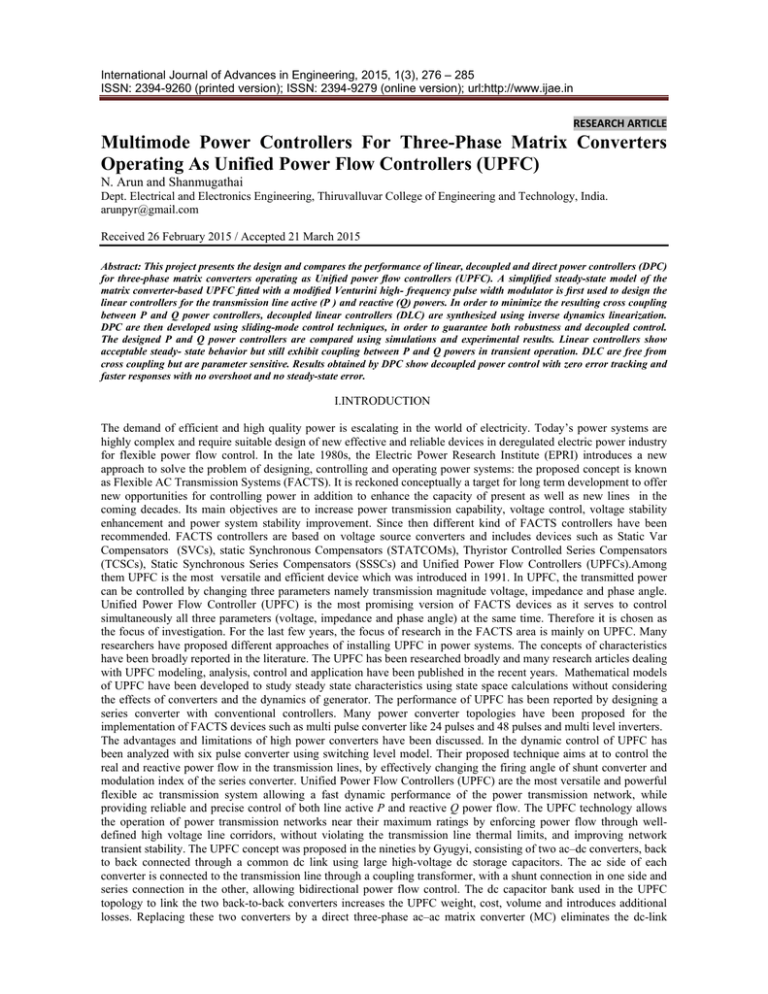
International Journal of Advances in Engineering, 2015, 1(3), 276 – 285 ISSN: 2394-9260 (printed version); ISSN: 2394-9279 (online version); url:http://www.ijae.in RESEARCH ARTICLE Multimode Power Controllers For Three-Phase Matrix Converters Operating As Unified Power Flow Controllers (UPFC) N. Arun and Shanmugathai Dept. Electrical and Electronics Engineering, Thiruvalluvar College of Engineering and Technology, India. arunpyr@gmail.com Received 26 February 2015 / Accepted 21 March 2015 Abstract: This project presents the design and compares the performance of linear, decoupled and direct power controllers (DPC) for three-phase matrix converters operating as Unified power flow controllers (UPFC). A simplified steady-state model of the matrix converter-based UPFC fitted with a modified Venturini high- frequency pulse width modulator is first used to design the linear controllers for the transmission line active (P ) and reactive (Q) powers. In order to minimize the resulting cross coupling between P and Q power controllers, decoupled linear controllers (DLC) are synthesized using inverse dynamics linearization. DPC are then developed using sliding-mode control techniques, in order to guarantee both robustness and decoupled control. The designed P and Q power controllers are compared using simulations and experimental results. Linear controllers show acceptable steady- state behavior but still exhibit coupling between P and Q powers in transient operation. DLC are free from cross coupling but are parameter sensitive. Results obtained by DPC show decoupled power control with zero error tracking and faster responses with no overshoot and no steady-state error. I.INTRODUCTION The demand of efficient and high quality power is escalating in the world of electricity. Today’s power systems are highly complex and require suitable design of new effective and reliable devices in deregulated electric power industry for flexible power flow control. In the late 1980s, the Electric Power Research Institute (EPRI) introduces a new approach to solve the problem of designing, controlling and operating power systems: the proposed concept is known as Flexible AC Transmission Systems (FACTS). It is reckoned conceptually a target for long term development to offer new opportunities for controlling power in addition to enhance the capacity of present as well as new lines in the coming decades. Its main objectives are to increase power transmission capability, voltage control, voltage stability enhancement and power system stability improvement. Since then different kind of FACTS controllers have been recommended. FACTS controllers are based on voltage source converters and includes devices such as Static Var Compensators (SVCs), static Synchronous Compensators (STATCOMs), Thyristor Controlled Series Compensators (TCSCs), Static Synchronous Series Compensators (SSSCs) and Unified Power Flow Controllers (UPFCs).Among them UPFC is the most versatile and efficient device which was introduced in 1991. In UPFC, the transmitted power can be controlled by changing three parameters namely transmission magnitude voltage, impedance and phase angle. Unified Power Flow Controller (UPFC) is the most promising version of FACTS devices as it serves to control simultaneously all three parameters (voltage, impedance and phase angle) at the same time. Therefore it is chosen as the focus of investigation. For the last few years, the focus of research in the FACTS area is mainly on UPFC. Many researchers have proposed different approaches of installing UPFC in power systems. The concepts of characteristics have been broadly reported in the literature. The UPFC has been researched broadly and many research articles dealing with UPFC modeling, analysis, control and application have been published in the recent years. Mathematical models of UPFC have been developed to study steady state characteristics using state space calculations without considering the effects of converters and the dynamics of generator. The performance of UPFC has been reported by designing a series converter with conventional controllers. Many power converter topologies have been proposed for the implementation of FACTS devices such as multi pulse converter like 24 pulses and 48 pulses and multi level inverters. The advantages and limitations of high power converters have been discussed. In the dynamic control of UPFC has been analyzed with six pulse converter using switching level model. Their proposed technique aims at to control the real and reactive power flow in the transmission lines, by effectively changing the firing angle of shunt converter and modulation index of the series converter. Unified Power Flow Controllers (UPFC) are the most versatile and powerful flexible ac transmission system allowing a fast dynamic performance of the power transmission network, while providing reliable and precise control of both line active P and reactive Q power flow. The UPFC technology allows the operation of power transmission networks near their maximum ratings by enforcing power flow through welldefined high voltage line corridors, without violating the transmission line thermal limits, and improving network transient stability. The UPFC concept was proposed in the nineties by Gyugyi, consisting of two ac–dc converters, back to back connected through a common dc link using large high-voltage dc storage capacitors. The ac side of each converter is connected to the transmission line through a coupling transformer, with a shunt connection in one side and series connection in the other, allowing bidirectional power flow control. The dc capacitor bank used in the UPFC topology to link the two back-to-back converters increases the UPFC weight, cost, volume and introduces additional losses. Replacing these two converters by a direct three-phase ac–ac matrix converter (MC) eliminates the dc-link 277 Int. J. Adv. Eng., 2015, 1(3), 276-285 capacitors, thus reducing costs, size, maintenance, while increasing reliability and lifetime. The ac–ac MC processes electrical energy directly without large storage needs, allows bidirectional power flow, guarantees near sinusoidal input and output currents, and controls the voltages amplitude and frequency at adjustable power factor. In the dependence of the MC output voltage with the modulation coefficient was investigated, being the UPFC able to control an extended range of power flow with lower power converters, usually sized for 10% of the line power . Figure.1 Transmission network with MC-UPFC. Usually, UPFC use conventional control methods based on power systems linearized models, valid around an operating point. These approaches do not guarantee robustness and may give origin to poor dynamic responses and/or undesired instability while nonlinear approaches allow a better tuning of linear controller parameters. Nonlinear robust direct power controllers (DPC) allow the dynamic response improvement based on sliding-mode control techniques to select adequate state-space vectors to control active and reactive powers in real time. In this project a matrix converter-based UPFC (MC-UPFC) for power transmission networks is used to control the P and Q power flow in a transmission line. Three different types of controllers are designed and tested: Proportional integral (PI) linear controllers obtained from a linear P and Q steady-state power UPFC linearized model, around an operating point, using a modified Venturing high frequency MC pulse width modulator (PWM). Decoupled linear controllers (DLC) designed by inverse dynamics linearization, allowing the elimination of the cross coupling effect between P and Q power controllers. DPC, which have been successfully used in power applications, owing to its simplicity and good performance. This control method, based on sliding-mode control techniques allows real-time selection of adequate statespace vectors to control input and output variables. These controllers are insensitive to power system nonlinearity, presenting robust behaviour to parameter variations and disturbances. Mathematical Modeling of UPFC In this model, we have considered the UPFC is placed at the centre of a 300km transmission line. This model was derived with to study the relationship between electrical transmission system and UPFC in steady state conditions. The basic scheme is shown in fig.3 [26]. A UPFC can be represented by two voltage sources representing fundamental components of output voltage waveforms of the two converters and impedances being leakage reactance of the two coupling transformers Based on the basic principle of UPFC and network theory, the active and reactive power flows in the line, from bus-i to bus-j. Figure.2 Equivalent circuit of UPFC 278 Int. J. Adv. Eng., 2015, 1(3), 276-285 Injection Model of UPFC: To obtain an injection model for UPFC, it is necessary to consider the series voltage source, Figure1.3. Figure.3 Representation of the series connected voltage source The injection model is obtained by replacing the voltage source V se by a current source Iinj = Vjbse in parallel with xs, Figure 3. Figure.4 Transformed series voltage source The apparent power supplied by the series voltage source converter is calculated from: Figure.5 Injection model of the series part of the UPFC Active and reactive power supplied by Converter 2 are distinguished as Afterwards, the series voltage source is coupled with the shunt part of the UPFC, which can be modeled as a separate controllable shunt reactive source. Here it is assumed that QCONV 1 = 0, but to allow for QCONV 1 6= 0 in the model is straight forward. Consequently, the UPFC injection model is constructed from series connected voltage source model with the addition of power equivalent to PCONV 1 + j0 to node i. The UPFC injection model is shown in Figure 6. Figure.6 Injection model of the UPFC Where r and q are the control variables of the UPFC. Besides the bus power injections, it is useful to have expressions for power flows from both sides of the UPFC injection model. The UPFC injection model is thereby the constant series branch susceptance, bs, which is included in the system bus admittance matrix, and the bus power injections Psi, Qsi, Psj and Qsj. If there is a control objective to be achieved, the bus power injections are modified through changes of the UPFC parameters r and Qconv1. II.UNIFIED POWER FLOW CONTROLLER A Unified Power Flow Controller (or UPFC) is an electrical device for providing fast-acting reactive power compensation on high-voltage electricity transmission networks. The UPFC is a versatile controller which can be used to control active and reactive power flows in a transmission line. The concept of UPFC makes it possible to handle practically all power flow control and transmission line compensation problems, using solid state controllers, which provide functional flexibility, generally not attainable by conventional thyristor controlled systems. 279 Int. J.. Adv. Eng., 20015, 1(3), 2766-285 The UPFC iss a combinatiion of a static synchronouss compensatorr (STATCOM)) and a staticc synchronous series compensator (SSSC) ( coupleed via a comm mon DC voltage link. It is capable off controlling simultaneouslly or line. The parrameters usuallly are selectively, all a the param meters affectingg the power flow in a transmission t voltage, impeddance and phasse angle. Figure.7 Blo ock diagram off Unified Power flow controlllers. This topology offers three degrees d of freedom or more precisely - foour degrees oof freedom (ttwo associatedd with each VSC) wiith one constraaint (active pow wers of the VSCs must match). Therrefore, a fundaamentally diff fferent range of conttrol options iss available com mpared to ST TATCOM or SSSC. S The UP PFC can be used u to controol the flow of activee and reactivee power througgh the line annd to control the amount of reactive pow wer supplied tto the line at the pooint of installaation. While opperating both iinverters as a UPFC, U the excchanged powerr at the terminals of each inverter can c be imaginaary as well as reeal. FC Figure.8 Sttructure of UPF ng both inverteers as a UPFC, the exchangeed power at thee terminals of each inverter can c be imaginaary as While operatin of the last genneration of FA well as real. Representative R ACTS devices is the Unifiedd Power Flow Controller (UP PFC). The UPFC is a device whicch can controll simultaneoussly all three parameters of lline power flow (line impeddance, p angle).T The UPFC com mbines togetheer the featuures of the Staatic Synchronnous Compennsator voltage and phase (STATCOM)aand the Static Synchronous Series Compensator (SSSC C). In practice, tthese two deviices are two Vooltage Source Invertters (VSI’s) co onnected respeectively in shuunt with the transmission lline through a shunt transfoormer and in series with the traansmission lin ne through a sseries transforrmer, connected to each othher by a common dc link including g a storage cappacitor. The shunt inverter is used forr voltage reguulation at the point p of conneection Injecting an opportune reeactive power flow into the t line and to t balance thhe real poweer flow exchaanged between the series inverteer and the trransmission liine. The series inverter cann be used to control c the reaal and reactive line power flow inserting an opportune o volttage with con ntrollable maggnitude and phase p in seriess with the transmissioon line Thereby, the UPFC can fulfill functtions of reactivve shunt compeensation, activee and reactive series compensation and phase sh hifting. Besides, the UPFC allows a secondary but impportant functioon such as staability control to supppress power syystem oscillatioons improving the transient stability s of pow wer system. Th he basic compoonents of the UPFC are a two voltagee source invertters (VSI's) ssharing a com mmon dc storaage capacitor, and connecteed to the system th hrough coupling transformerss. One VSI is connected in shunt to the transmission t s system via a shunt transformer, while w the othher one is coonnected in series through h a series trannsformer. Thee series invertter is controlled to inject a symm metrical three phase p voltage ssystem of conttrollable magniitude and phaase angle in series with the line to control acttive and reacttive power floows on the traansmission linne. So, this inv verter will exchhange active and reaactive power with w the line. The T reactive poower is electro onically providded by the seriies inverter, annd the active power is i transmitted to t the dc termiinals. The shuunt inverter is operated in such a way as to demandd this 280 Int. J. Adv. Eng., 2015, 1(3), 276-285 dc terminal power (positive or negative) from the line keeping the voltage across the storage capacitor Vdc constant. III.OPERATING PRINCIPLES OF UPFC Figure.9 Control scheme for the proposed methods The UPFC is the most versatile and complex of the FACTS devices, combining the features of the STATCOM and the SSSC. The main reasons behind the wide spreads of UPFC are: its ability to pass the real power flow bi-directionally, maintaining well regulated DC voltage, workability in the wide range of operating conditions etc .The basic components of the UPFC are two voltage source inverters (VSIs) sharing a common dc storage capacitor, and connected to the power system through coupling transformers. One VSI is connected to in shunt to the transmission system via a shunt transformer, while the other one is connected in series through a series transformer. The DC terminals of the two VSCs are coupled and this creates a path for active power exchange between the converters. Thus the active supplied to the line by the series converter can be supplied by the shunt converter as shown in figure. Figure.10 Basic circuit arrangement of UPFC Figure.11 Phasor Diagram of UPFC 281 Int. J. Adv. Eng., 2015, 1(3), 276-285 Figure.12 Equivalent circuit of UPFC Therefore, a different range of control options is available compared to STATCOM or SSSC. The UPFC can be used to control the flow of active and reactive power through the transmission line and to control the amount of reactive power supplied to the transmission line at the point of installation. Matrix Converter :Basically, a matrix converter (MC) is composed by 9 bidirectional switches, as shown in Fig. 3.11, where each dot of the grid represents a connection between the output and the input terminals. The converter is usually fed at the input side by a three phase voltage source and it is connected to an inductive load at the output side. The schematic circuit of a matrix converter feeding a passive load is shown in Fig. 3.12. The system is composed by the voltage supply, an L-C input filter, and the MC and load impedance. Figure.13 Basic scheme of matrix converters. Input Filter: The input filter is generally needed to smooth the input currents and to satisfy the EMI requirements. A reactive current flows through the input filter capacitor, leading to a reduction of the power factor, especially at low output power. As a consequence, the capacitor is chosen in order to ensure at least a power factor of 0.8 with 10% of the rated output power. After the selection of the capacitor, the input filter inductance of the matrix converter can be chosen in order to satisfy the IEEE Recommended Practices and Requirements for Harmonic Control in Electrical Power Systems (IEEE Std. 519-1992). IV. SIMULATION RESULT 282 Int. J. Adv. Eng., 2015, 1(3), 276-285 The performance of the proposed control methods was evaluated first using a detailed simulation model representing the Three-phase MC, series and shunt transformers, sources, trans-mission lines, loads, and additional blocks to simulate the control system using MATLAB/Simulink SimPowerSystems tool-ox. MC semiconductors were simulated as Sim Power System switches with appropriate snubbers. Figure.14 Matrix converter switch Model Figure.15 Matrix converter switch subsystem Figure.16 Matrix converter 3 phase o/p voltage Figure.17 Matrix converter 3 o/p current 283 Figure.18 Matrix converter 3phase o/p current Int. J. Adv. Eng., 2015, 1(3), 276-285 Figure.19 Matrix converter active (P) and Reactive Power(Q) Figure.20 Matrix converter Based unified power flow control Figure.21 UPFC Data Acquisition control 284 Int. J. Adv. Eng., 2015, 1(3), 276-285 Figure.21 STATCOM wave model Figure.21 UPFC wave model CONCLUSION This paper designs and compares three different control methods for active and reactive power flow using MCs connected to power transmission lines as UPFC: PI linear controllers, DLC, and sliding-mode-based nonlinear DPC. MC-UPFCs need almost no energy storage, which is a clear advantage in the converter sizing and design, and the proposed controllers and high frequency filter placement were chosen to obtain control parameters almost independent of load and filter characteristics. Simulation and experimental results show that P and Q power flow can be effectively controlled using the MC-UPFC and one of the three controllers. The nonlinear DPC methodology show no steady-state errors, no cross coupling, insensitivity to non-modeled dynamics, fast response times, and low THD, whereas the simpler PI linear P and Q power controllers using a modified Venturini high-frequency PWM show a small cross coupling and slower response times. DLC, although dependent on system parameters, show no cross coupling, fast response, and small ripples in steady state, but higher THD. ACKNOWLEDGEMENT At the outset, I express my gratitude and thanks to our principal, Dr. S.Arunachalam, M.E., Ph.D., and management of Thiruvalluvar College of Engineering for extending all the instrumentation and facilities. I wish to express my sincere thanks to our Head of the Department Prof. V. Balu, M.E., Ph.D., for his guidance, useful comments and excellent encouragement in course of this work. I wish to thank with deep sense of acknowledge to my supervisor Miss.Shanmugathai, M.E., for his valuable mentorship, timely suggestions and encouragement during all phases of this work. I take immense pleasure in conveying my thanks to our project co-coordinator Mr.P. Suresh, M.E. for his valuable support for completion of this project. I would like to thank our department faculty members are Asst. Prof. Mr.A.Manivannan, M.E., Mr.C.Anandraj, M.E.,Mrs.R.Divyabharathi,M.E.,cMiss. K.Shanmugathai,M.E,Mr.S.K. Ezhilarasu ,M.E and others. I would also like to thank all my classmates for sharing their views on the project issues. 285 Int. J. Adv. Eng., 2015, 1(3), 276-285 REFERENCES [1] J. Chivite-Zabalza, P. Izurza-Moreno, D. Madariaga, G. Calvo, and M. A. Rodriguez, “Voltage balancing control in 3-level neutral-point clamped inverters using triangular carrier PWM modulation for FACTS applications,” IEEE Trans. Power Electron., vol. 28, no. 10, pp. 4473– 4484, Oct. 2013. [2] J. Chivite-Zabalza, M. A. Rodr´ıguez Vidal, P. Izurza-Moreno, G. Calvo, and D. Madariaga, “A large power, lowswitching-frequency voltage source converter for FACTS applications with low effects on the transmission line,” IEEE Trans. Power Electron., vol. 27, no. 12, pp. 4868–4879, Dec. 2012. [3] K. Wang, L. M. Crow, B. McMillin, and S. Atcitty, “A novel real-time approach to unified power flow controller validation,” IEEE Trans. Power Syst., vol. 25, no. 4, pp. 1892–1901, Nov. 2010. [4] M. A. Sayed and T. Takeshita, “All nodes voltage regulation and line loss minimization in loop distribution systems using UPFC,” IEEE Trans. Power Electron., vol. 26, no. 6, pp. 1694–1703, Jun. 2011. [5] M. Zarghami, L. M. Crow, J. Sarangapani, L. Yilu, and S. Atcitty, “A novel approach to interarea oscillation damping by unified power flow controllers utilizing ultra capacitors,” IEEE Trans. Power Syst., vol. 25, no. 1, pp. 404–412, Feb. 2010. [6] J. Hu and Z. Q. Zhu, “Investigation on switching patterns of direct power control strategies for grid-connected DC–AC converters based on power variation rates,” IEEE Trans. Power Electron., vol. 26, no. 12, pp. 3582– 3598, Dec. 2011. [7] N. Zhang, Z. Li, Y. Zhang, W. Xie, Z. Piao, and C. Hu, “Performance improvement of direct power control of PWM rectifier with simple calculation,” IEEE Trans. Power Electron., vol. 28, no. 7, pp. 3428–3437, Jul. 2013. [8] N. Hingorani and L. Gyugyi, Understanding FACTS—Concepts and Technology of Flexible AC Transmission Systems. Piscataway, NJ, USA:IEEE Press, 2000. 9] P. Chivite-Zabalza, P. Izurza-Moreno, D. Madariaga, G. Calvo, and M. A. Rodriguez, “Voltage balancing control in 3-level neutral-point clamped inverters using triangular carrier PWM modulation for FACTS applications,” IEEE Trans. Power Electron., vol. 28, no. 10, pp. 4473–4484, Oct. 2013. [10] R. Chivite-Zabalza, M. A. Rodr´ ıguez Vidal, P. Izurza-Moreno, G. Calvo, and D. Madariaga, “A large power, low-switching-frequency voltage source converter for FACTS applications with low effects on the transmission line,” IEEE Trans. Power Electron., vol. 27, no. 12, pp. 4868–4879,Dec. 2012. [11] Y. Wang, L. M. Crow, B. McMillin, and S. Atcitty, “A novel real-time approach to unified power flow controller validation,” IEEE Trans. Power Syst., vol. 25, no. 4, pp. 1892–1901, Nov. 2010. [12] Z. A. Sayed and T. Takeshita, “All nodes voltage regulation and line loss minimization in loop distribution systems using UPFC,” IEEE Trans.Power Electron., vol. 26, no. 6, pp. 1694–1703, Jun. 2011.

